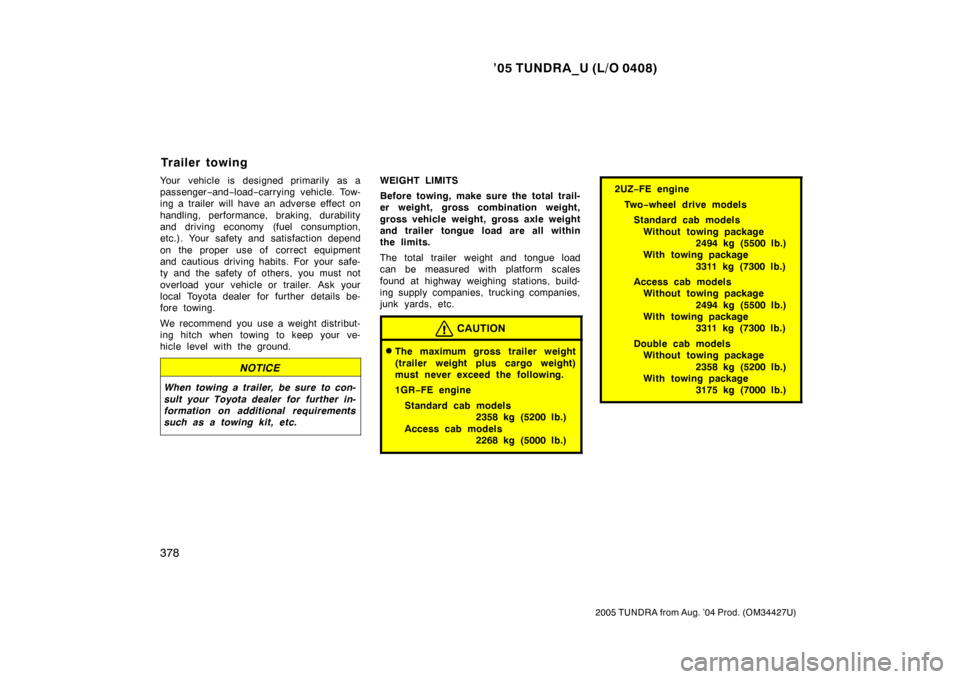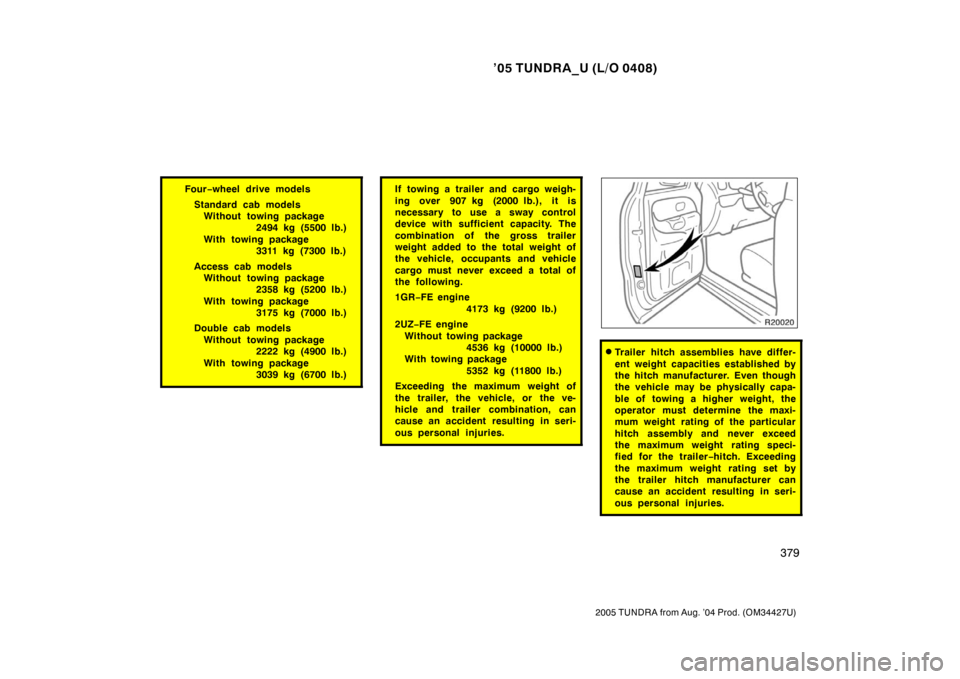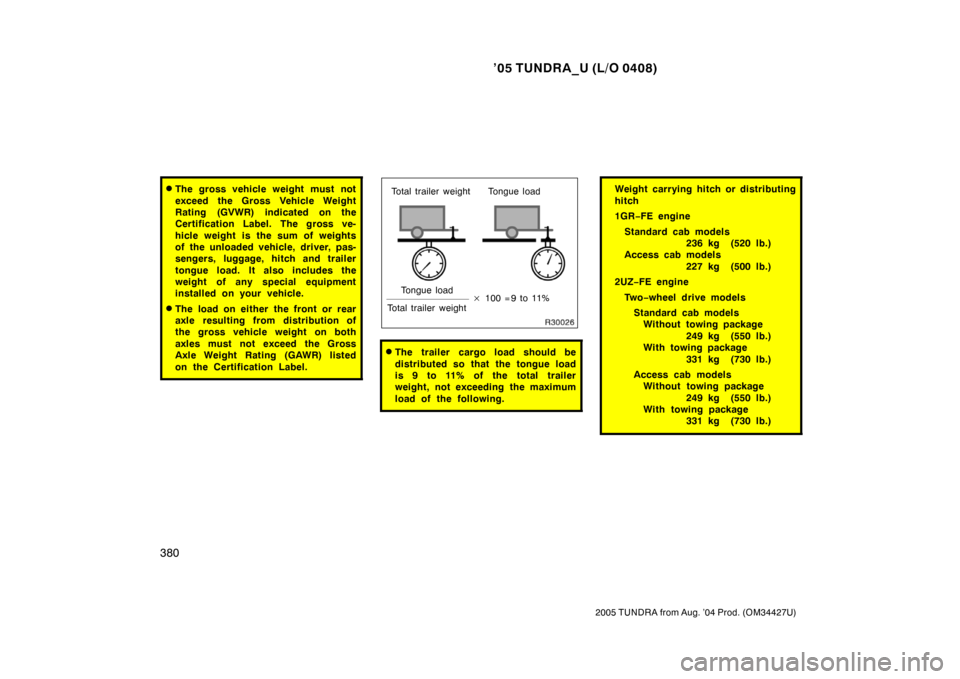Page 382 of 506
’05 TUNDRA_U (L/O 0408)
371
2005 TUNDRA from Aug. ’04 Prod. (OM34427U)
STARTING AND DRIVING
Starting and driving
Before starting the engine 372
. . . . . . . . . . . . . . . . . . . . . . . . . . . . . . . . . . .
How to start the engine 372
. . . . . . . . . . . . . . . . . . . . . . . . . . . . . . . . . . . . \
. .
Tips for driving in various conditions 373
. . . . . . . . . . . . . . . . . . . . . . . . . .
Off −road driving precautions 375
. . . . . . . . . . . . . . . . . . . . . . . . . . . . . . . . .
Winter driving tips 376
. . . . . . . . . . . . . . . . . . . . . . . . . . . . . . . . . . . . \
. . . . . .
Dinghy towing 377
. . . . . . . . . . . . . . . . . . . . . . . . . . . . . . . . . . . . \
. . . . . . . . . .
Trailer towing 378
. . . . . . . . . . . . . . . . . . . . . . . . . . . . . . . . . . . . \
. . . . . . . . . .
How to save fuel and make your vehicle last longer 389
. . . . . . . . . . . . .
SECTION 3
Page 388 of 506

’05 TUNDRA_U (L/O 0408)
377
2005 TUNDRA from Aug. ’04 Prod. (OM34427U)
Check the condition of the battery and
cables.
Cold temperatures reduce the capacity of
any battery, so it must be in top shape
to provide enough power for winter start-
ing. Section 7 −3 tells you how to visually
inspect the battery. Your Toyota dealer
and most service stations will be pleased
to check the level of charge.
Make sure the engine oil viscosity is
suitable for the cold weather.
See Section 7 −2 for recommended viscos-
ity. Leaving a heavy summer oil in your
vehicle during winter months may cause
harder starting. If you are not sure about
which oil to use, call your Toyota deal-
er—they will be pleased to help.
Keep the door locks from freezing.
Squirt lock de −icer or glycerine into the
locks to keep them from freezing. To open
a frozen lock, try heating the key before
inserting it.
Use a washer fluid containing an anti-
freeze solution.
This product is available at your Toyota
dealer and most auto parts stores. Follow
the manufacturer ’s directions for how
much to mix with water.NOTICE
Do not use engine antifreeze or any
other substitute because it may dam-
age your vehicle’s paint.
Do not use your parking brake when
there is a possibility it could freeze.
When parking, put the transmission into
“P” (automatic) or into first or reverse
(manual) and block the front wheels. Do
not use the parking brake, or snow or
water accumulated in and around the
parking brake mechanism may freeze,
making it hard to release.
Keep ice and snow from accumulating
under the fenders.
Ice and snow built up under your fenders
can make steering difficult. During bad
winter driving, stop and check under the
fenders occasionally.
Depending on where you are driving,
we recommend you carry some emer-
gency equipment.
Some of the things you might put in the
vehicle are tire chains, window scraper,
bag of sand or salt, flares, small shovel,
jumper cables, etc.
Your vehicle is not designed to be
dinghy towed (with four wheels on the
ground) behind a motorhome.
NOTICE
Do not tow your vehicle with four
wheels on the ground. This may
cause serious damage to your vehicle.
Dinghy towing
Page 389 of 506

’05 TUNDRA_U (L/O 0408)
378
2005 TUNDRA from Aug. ’04 Prod. (OM34427U)
Your vehicle is designed primarily as a
passenger −and− load− carrying vehicle. Tow-
ing a trailer will have an adverse effect on
handling, performance, braking, durability
and driving economy (fuel consumption,
etc.). Your safety and satisfaction depend
on the proper use of correct equipment
and cautious driving habits. For your safe-
ty and the safety of others, you must not
overload your vehicle or trailer. Ask your
local Toyota dealer for further details be-
fore towing.
We recommend you use a weight distribut-
ing hitch when towing to keep your ve-
hicle level with the ground.
NOTICE
When towing a trailer, be sure to con-
sult your Toyota dealer for further in-
formation on additional requirements
such as a towing kit, etc.
WEIGHT LIMITS
Before towing, make sure the total trail-
er weight, gross combination weight,
gross vehicle weight, gross axle weight
and trailer tongue load are all within
the limits.
The total trailer weight and tongue load
can be measured with platform scales
found at highway weighing stations, build-
ing supply companies, trucking companies,
junk yards, etc.
CAUTION
�The maximum gross trailer weight
(trailer weight plus cargo weight)
must never exceed the following.
1GR −FE engine
Standard cab models 2358 kg (5200 lb.)
Access cab models 2268 kg (5000 lb.)
2UZ−FE engine
Tw o −wheel drive models
Standard cab models Without towing package 2494 kg (5500 lb.)
With towing package
3311 kg (7300 lb.)
Access cab models Without towing package
2494 kg (5500 lb.)
With towing package 3311 kg (7300 lb.)
Double cab models Without towing package
2358 kg (5200 lb.)
With towing package 3175 kg (7000 lb.)
Trailer towing
Page 390 of 506

’05 TUNDRA_U (L/O 0408)
379
2005 TUNDRA from Aug. ’04 Prod. (OM34427U)
Four−wheel drive models
Standard cab models Without towing package 2494 kg (5500 lb.)
With towing package 3311 kg (7300 lb.)
Access cab models Without towing package 2358 kg (5200 lb.)
With towing package 3175 kg (7000 lb.)
Double cab models Without towing package 2222 kg (4900 lb.)
With towing package 3039 kg (6700 lb.)If towing a trailer and cargo weigh-
ing over 907 kg (2000 lb.), it is
necessary to use a sway control
device with sufficient capacity. The
combination of the gross trailer
weight added to the total weight of
the vehicle, occupants and vehicle
cargo must never exceed a total of
the following.
1GR−FE engine
4173 kg (9200 lb.)
2UZ− FE engine
Without towing package 4536 kg (10000 lb.)
With towing package
5352 kg (11800 lb.)
Exceeding the maximum weight of
the trailer, the vehicle, or the ve-
hicle and trailer combination, can
cause an accident resulting in seri-
ous personal injuries.
�Trailer hitch assemblies have differ-
ent weight capacities established by
the hitch manufacturer. Even though
the vehicle may be physically capa-
ble of towing a higher weight, the
operator must determine the maxi-
mum weight rating of the particular
hitch assembly and never exceed
the maximum weight rating speci-
fied for the trailer −hitch. Exceeding
the maximum weight rating set by
the trailer hitch manufacturer can
cause an accident resulting in seri-
ous personal injuries.
Page 391 of 506

’05 TUNDRA_U (L/O 0408)
380
2005 TUNDRA from Aug. ’04 Prod. (OM34427U)
�The gross vehicle weight must not
exceed the Gross Vehicle Weight
Rating (GVWR) indicated on the
Certification Label. The gross ve-
hicle weight is the sum of weights
of the unloaded vehicle, driver, pas-
sengers, luggage, hitch and trailer
tongue load. It also includes the
weight of any special equipment
installed on your vehicle.
�The load on either the front or rear
axle resulting from distribution of
the gross vehicle weight on both
axles must not exceed the Gross
Axle Weight Rating (GAWR) listed
on the Certification Label.� 100 = 9 to 11%
Total trailer weight Tongue load
Tongue load
Total trailer weight
�The trailer cargo load should be
distributed so that the tongue load
is 9 to 11% of the total trailer
weight, not exceeding the maximum
load of the following.
Weight carrying hitch or distributing
hitch
1GR −FE engine
Standard cab models 236 kg (520 lb.)
Access cab models
227 kg (500 lb.)
2UZ− FE engine
Tw o −wheel drive models
Standard cab models Without towing package
249 kg (550 lb.)
With towing package
331 kg (730 lb.)
Access cab models Without towing package
249 kg (550 lb.)
With towing package 331 kg (730 lb.)
Page 392 of 506

’05 TUNDRA_U (L/O 0408)
381
2005 TUNDRA from Aug. ’04 Prod. (OM34427U)
Double cab models
Without towing package 236 kg (520 lb.)
With towing package
318 kg (700 lb.)
Four −wheel drive models
Standard cab models Without towing package 249 kg (550 lb.)
With towing package 331 kg (730 lb.)
Access cab models Without towing package 236 kg (520 lb.)
With towing package 318 kg (700 lb.)
Double cab models Without towing package 222 kg (490 lb.)
With towing package
304 kg (670 lb.)However, if towing with a fifth
wheel trailer, the cargo load must
be distributed so that the tongue
load is 19 to 21% of the total trailer
weight. Never load the trailer with
more weight in the back than in the
front. About 60% of the trailer load
should be in the front half of the
trailer and the remaining 40% in the
rear.HITCHES
�If you wish to install a trailer hitch, you
should consult with your Toyota dealer.
�Use only a hitch recommended by the
hitch manufacturer and the one which
conforms to the total trailer weight
requirement.
�The hitch must be bolted securely to
the vehicle frame and installed accord-
ing to the hitch manufacturer ’s instruc-
tions.
�The hitch ball and king pin should have
a light coat of grease.
�Toyota recommends removing the trail-
er hitch whenever you are not towing
a trailer to reduce the possibility of
additional damage caused by the hitch
if your vehicle is struck from behind.
After removing the hitch, seal any
mounting holes in the vehicle body to
prevent entry of pollutants such as ex-
haust fumes, dirt, water, etc.
Page 394 of 506
’05 TUNDRA_U (L/O 0408)
383
2005 TUNDRA from Aug. ’04 Prod. (OM34427U)
NOTICE
Vehicles with 2UZ− FE engine (with
towing package)—Only use a ball
mount attachment specified for the
Toyota Tundra.
BUMPER TOWING
The rear bumper of your vehicle is
equipped with a hole to install a trailer
ball. The maximum gross trailer weight is
2268 kg (5000 lb.).
CAUTION
The maximum gross trailer weight
(trailer weight plus cargo weight)
when towing with the bumper must
never exceed 2268 kg (5000 lb.).
FIFTH WHEEL TRAILER
NOTICE
When towing a fifth wheel trailer, be
careful not to hit the cabin or deck
by the trailer while making a sharp
turn.
Page 395 of 506

’05 TUNDRA_U (L/O 0408)
384
2005 TUNDRA from Aug. ’04 Prod. (OM34427U)
1 Coupler
2 Trailer ball
MATCHING TRAILER BALL HEIGHT TO
TRAILER COUPLER HEIGHT
No matter which class of tow hitch ap-
plies, for a safe trailer hookup, the trailer
ball setup on must be the proper height
for the coupler on the trailer.
BRAKES AND SAFETY CHAINS
�Toyota recommends trailers with
brakes that conform to any applica-
ble federal and state/provincial regu-
lations.
�A safety chain must always be used
between the towing vehicle and the
trailer. Leave sufficient slack in the
chain for turns. The chain should
cross under the trailer tongue to
prevent the tongue from dropping to
the ground in case it becomes dam-
aged or separated. For correct safety
chain procedures, follow the hitch or
trailer manufacturer ’s recommenda-
tions.
CAUTION
�If the total trailer weight exceeds
453 kg (1000 lb.), trailer brakes are
required.
�Never tap into your vehicle’s hy-
draulic system as it would lower its
braking effectiveness.
�Never tow a trailer without using a
safety chain securely attached to
both the trailer and the vehicle. If
damage occurs to the coupling unit
or hitch ball, there is danger of the
trailer wandering over into another
lane.